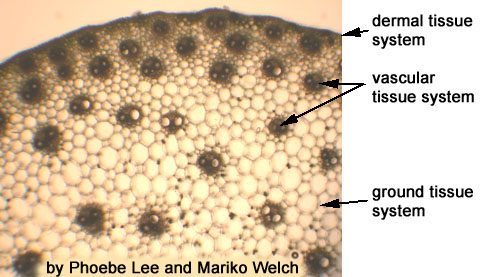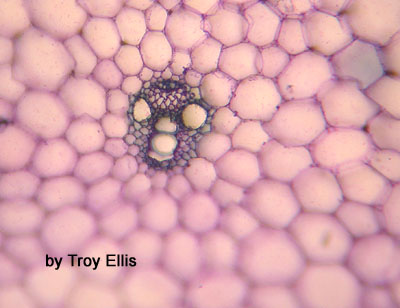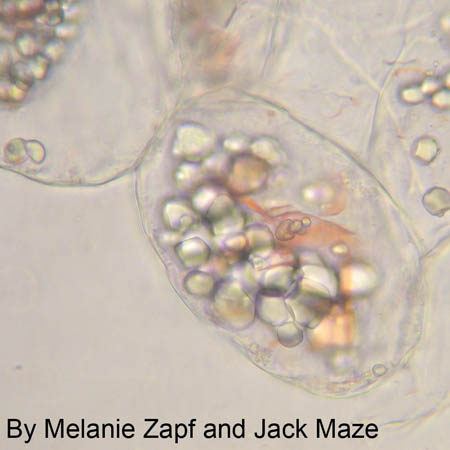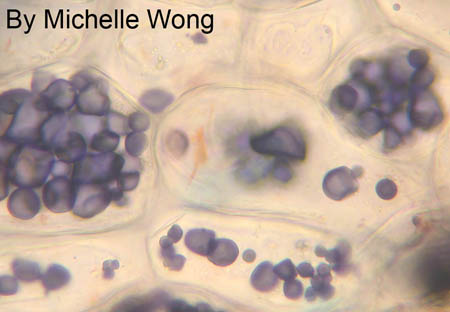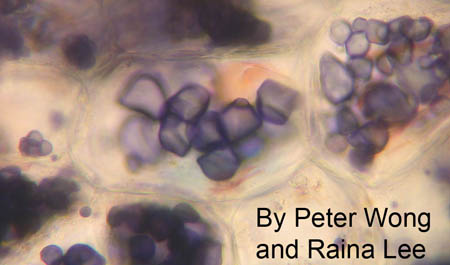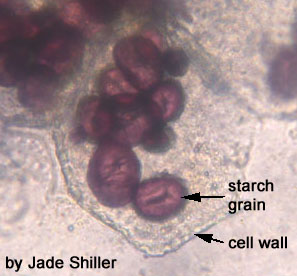Tissue Systems
Vascular plants are made up of three tissue systems:
- dermal tissue system (outer skin of plant)
- vascular tissue system (conductive tissues of plant)
- ground tissue system (all the filler in between the above two)
The tissue systems can be made up of more than one type of tissue. For example the vascular tissue system is made up of two tissue types (xylem tissue and phloem tissue).
In lab we will examine two examples. This is not only to introduce tissue systems in general, but also to give you the opportunity to review the use of the compound microscope, slide preparation, and staining.
Example 1 – Corn Stem
Three Tissue Systems
Here is a picture through a corn stem (unstained). Note the location of the three tissue systems.
Here is a closer look at a stained specimen.
Here is another excellent slide. Can you identify the three tissue systems?
The vascular tissue system of corn looks a little like a face. The large eyes, nose, and mouth are the water conducting cells of the xylem tissue. These are actually dead cells so appear hollow. Other cells of the xylem tissue are living.
A closer look at the bundle……. The section has been stained with toluidine blue. Notice that the cell walls which have been lignified (like the vessel element indicated with the blue arrow) stains light blue. The cell walls which are not lignified (ie. do not have lignin) stain purple like the phloem cells indicated with the purple arrow.
This close-up shows you the two types of tissue found in the vascular tissue system (phloem and xylem). Unlike the conductive cells of the xylem, the phloem conductive cells are living. Both xylem and phloem are complex tissues. This means that each tissue is made up of many cell types. You can see this particularly well with the xylem. You can see the tracheary elements, parenchyma cells and in between the “eyes” there are fibre cells….tune in next week for more details!!!!!!!
Example 2 – Yam (we didn’t do this in lab so this is a bonus!)
Modified Storage in Vascular Tissue System
Sections were made from the root of a “yam”. You can see the carotenoids (orange) which are inside of chromoplasts. The amyloplasts, containing starch grains are the the colourless, variously shaped structures within the cell.
Note: The yams we buy in the store are just a type of sweet potato; true yams are a different species, in a different plant family.
Staining with IKI confirms that there is starch in the cells! Starch stains purple (unless you overstain and then it turns black!).
Example 3 – Bean Seed (we didn’t do this in lab so this is a bonus!)
Ground Tissue System
When the seedcoat is removed from a bean seed you are left with an embryo. Most of the embryo consists of two large cotyledons (we will go into greater detail in the next few weeks). Cotyledons are the embryonic leaves which store nutrients/energy, important for the germination and growth of a young seedling. The storage tissue is parenchyma of the ground tissue system.
This is an unstained section through the cotyledon of a bean. You can see the large isodiametric parenchyma cells which contain a number of starch grains. The starch grains are stored within amyloplasts (a type of leucoplast).
This specimen has been stained with IKI, which stains starch purple to black. Starch is a common storage product in plants. Can you think of other parenchyma tissue you eat that is starchy? From what plant is it derived?
To put the tissue types in the context of the tissue systems refer to page 15 of your lab manual. Over the next few weeks we will be covering this in greater detail.
BACK TO INTRO
CELL AND TISSUE TYPES (LAB #2)
ORGANIZATION OF TISSUE SYSTEMS IN PLANT ORGANS (Preview to Labs 3, 4, AND 5)

